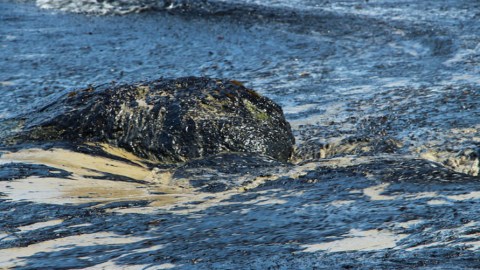Is the Santa Barbara Oil Spill Any Different?

I grew up not far from Santa Barbara, California. That means I spent a lot of time there as a youth because — well — it’s Santa Barbara. The place is gorgeous, pristine; it’s the gateway to California’s Central Coast and some of the Earth’s most beautiful locales. So you can probably understand the frustration I felt when news got out this week about the Refugio Oil Spill located just up the road, where 20,000 gallons of crude oil bled into the ocean and have wreaked havoc on the local beach and wildlife.
A ruptured pipe along the Plains All American pipeline proved to be the culprit. Investigators and authorities are still looking for answers as to what caused the hemorrhage (one should note that Plains All American doesn’t have the most shining safety record), but finger-pointing at this point does little for local residents and those concerned about the fragile ecosystem along the nine square miles of polluted beach and sea. Reporters Tony Barboza and Javier Panzar of the Los Angeles Timeshave the scoop on the around-the-clock cleanup efforts currently in progress:
“‘Cleanup doesn’t happen overnight,’ Capt. Jennifer Williams of the U.S. Coast Guard said at a news conference. ‘You may see some progress early on, maybe in the first week or two. … But these types of things continue on for perhaps even months…’
Experts describe the spill as moderate in size but have said it still could have a dramatic impact in an environmentally sensitive area such as the Gaviota Coast. The region hosts rare seabirds, migrating whales, sea lions, dolphins and other marine mammals. It is also home to two state Marine Protected Areas that safeguard sea life.”
Several experts from local Southern California universities are quoted in the article. The common refrain is that the spill’s location makes it uniquely dire. Surface and beach cleanup will only remove what the eye can see. Oil that seeps into organisms and beneath sediment will affect biological communities for years.
While there are plenty of upsetting photos of oil-drenched birds and sea lions, what’s most frustrating here is that there’s little hope for progress. What’s going to happen now? Tourism will suffer; local ecology will weaken; the pipeline company will get fined; politicians will stonewall each other with irrational arguments; and we’ll all just wait for the next spill. The resonant feeling right now is frustration.
I understand not everyone believes in renewable energy or animal protection or any of an assortment of other green issues. Honestly, those aren’t often my biggest priorities either. But I can’t imagine why anyone would disagree that we shouldn’t act as stewards of our lands and localities. If not for god or country or our progeny, merely because it’s the right thing to do. Are opponents of efforts to reduce our reliance on oil intentionally uncaring? Do they just all live in flyover country where there aren’t any beloved coastlines to ruin?
And really, is anything bound to change? I’m not so hopeful. To too many, places like Refugio State Beach are treated as collateral damage. “Oh well, sorry about your beach there, but that’s the cost of doing business.” I can’t understand why that’s an okay perspective to have. I can’t understand why conservation is such a naughty word to some folks.
It feels irresponsible.
And it’s frustrating.
Read more at the LA Times
Below, Matthew C. Nisbet, then a professor at American University, discusses the public reaction to the massive BP Oil Spill in 2010:
Photo credit: Zackmann08 / WikiCommons




